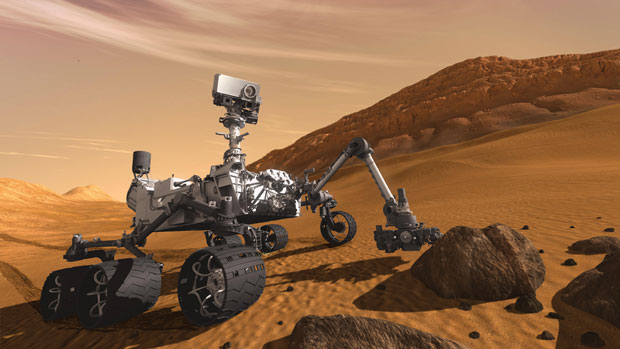Starry Skies
Curiosity goes to Mars
November 2011
Curiosity goes to Mars
November 2011

An artist’s conception of NASA rover “Curiosity” examining a rock on Mars (Image credit: NASA/JPL-Caltech)
In this case, Curiosity is the renamed “Mars Science Laboratory.” This rover is scheduled for a Nov. 25, 2011 launch from NASA’s Kennedy Space Center in Florida. If it doesn’t make this launch date, the window will remain open until Dec. 18. If it launches on schedule, Curiosity should arrive at Mars in August 2012.
Since it borrowed many features from its predecessors, Spirit and Opportunity, Curiosity looks very much like them except it is a lot bigger. Measuring 10 feet by 9 feet x 7 feet and weighing close to a ton, this is a rover on steroids. Because of its size, it cannot be dropped like other rovers where the landing has been cushioned by air bags. Curiosity will use a new landing mechanism called a ‘Sky Crane.’
With this system, once the heat shield has been jettisoned a parachute will open to slow the capsule containing the rover further, then the parachute will also be jettisoned and retro rockets will kick in, slowing the assembly to just over one mile per hour. Once it is about 65 feet above the ground, the Sky Crane will start lowering the rover by a tether. When the rover touches the ground, the tether will be cut, causing the capsule to fly clear of the landing area. This landing method has two advantages over the previously used system. First, it will test the methodology for landing heavy objects, which is a requirement for the proposed sample return mission. Second, it can place the payload more accurately – in this case within an oval of 16 by 12 miles. Compare this to the previous rovers whose landing area was an oval of 93 by 12 miles. Of course, the landing will be a lot trickier.
The mission is initially scheduled to last one Martian year, which is equal to 23 Earth months. During that time, Curiosity will use its 10 science instruments to search the environment, checking for past or present ability to sustain microbial life. Note that it is not looking for life itself. It will, however, be able to indicate where to look for any life in the future. It will also be looking at climate and radiation with the aim of determining human exploration needs.
One major difference between this rover and its predecessors is its power source. Spirit and Opportunity used solar panels, which had two major drawbacks: The rovers were limited to exploring a narrow band close to the Martian equator, and the panels would get dusty causing power problems. Curiosity’s power source is similar to those used by probes exploring the outer solar system and the Viking landers. This uses a radioisotope (nonweapons-grade plutonium) to generate electricity. Interestingly, the United States stopped producing plutonium in 1988 and since 1992 has been buying this particular form of it from Russia. That deal is being renegotiated, but until it is resolved, future deep space missions are in jeopardy.
The Exploratorium will be offering a live webcast of the Mars Curiosity rover launch both in house an online at www.explorato rium.edu/mars/index.html. The webcast will be sometime between Friday, Nov. 25 and Sunday, Dec. 18, 2011 (NASA will announce the exact launch date and time just prior to Nov. 25). The live webcast will be shown on big screens for Exploratorium visitors in the Phyllis C. Wattis Webcast Studio on the museum’s main floor. Moderating the event will be one of the Exploratorium’s staff senior scientists, Ron Hipschman. For more on NASA’s Mars Curiosity rover project, go to www.nasa.gov/mission_pages/msl/index.html.
Keith Turner is a retired physicist and longtime Marina resident.


